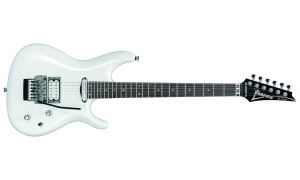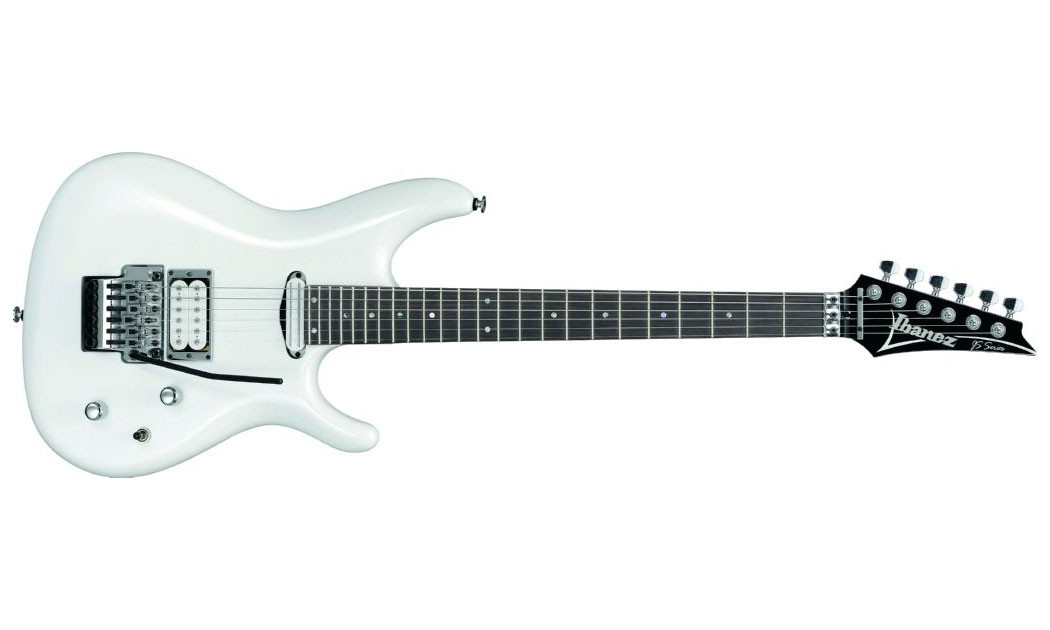View other reviews for this product:
« Ibanez JS2400 »
Published on 05/27/11 at 15:00With a maple JS Prestige bolt-on neck and rosewood fingerboard, moving quick on the JS2400, whether sweeping or performing scalar runs, is far more effortless than with other guitars in its price-range.
There is a sense of fluidity with this guitar. The small neck (20mm at the 1st fret and 22.3mm at the 12th) may have something to do with it, together with my smallish hands and fingers (I have tried Vais JEM models, and its larger neck to accommodate Vais long fingers resulted in more struggled playing on my part). The curve of the neck also has an influence on the ease of play, as string bending not only is easier than with the other quality guitars in my collection, but you can achieve higher notes while bending as a result. The finish on the neck is worth talking about: the silk-like lacquer does not make the neck sticky as the hand sweats, unlike heavy, glossy lacquer found on other guitars. This allows the player to maintain speed and technique without having to fight the stick.
The basswood body allows for a very rich and somewhat mellow tone, although the harmonics and squeals that can emanate from the guitar are some of the best and easiest to achieve. What make the body special, in terms of appearance and comfort, are the many contours and rounded edges that fit the guitarist like a glove. Further, the lower horn of the body is cut in such a way as to allow excellent clearance of the fretting hand; its easy to work high up on the neck without any obstruction.
The JS2400 sports a low-profile Edge tremolo bridge, with knife-edge-like pivot surfaces for near-zero friction and locking studs to help maintain tuning stability. Also, the fine-tuners are angled back to prevent any picking-hand contact and possible de-tuning. Most importantly, although this is a floating bridge system, I have found it takes a lot of whammy usage for this guitar to go out of tune.
The neck pickup is a DiMarzio Pro Track ceramic humbucker that sports twin blades to prevent problems associated with string-alignment dropouts. It is a narrow humbucker, which means it can be placed right up against the base of the neck for best tone, as opposed to the larger humbuckers that shift down on the body.
It gives a nice throaty tone and offers a great blues sound. And yet, when adjusting the tone knob around the halfway position, the pinch-harmonics ring out clearly. I use this pickup frequently as it does not sound overly dark or muddy, but very rich.
The bridge pickup is an Alnico DiMarzio Mo Joe Humbucker that is powerful (more so than the Fred pickup he used on older model guitars), yet maintains its clarity of dynamics and definition. It does not have a crass sound to it, like other pickups designed for the rock genre.
Rather, even when put through plenty of distortion and overdrive, this pickup rings clear as if it is a super-charged Strat pickup.
The tone possibilities are vast, as you can switch between neck and bridge, or both neck and bridge pickups. Nothing unusual there. But you also can pop the volume button (via a coil tap switch) to split the bridge pickup for a thinner tone, thus giving two more tonal variations as you use it on its own or in combination with the neck pickup. And then, as you fine-tune the tone knob, the subtleties become apparent and diverse.
The volume control electronics also is of fine workmanship; as the volume is lowered you do not lose very much, if any gain or distortion. This is important if adjusting volume of the guitar to match the volume of the band, from a slightly quieter rhythm to a more searing lead.
Not many guitars allow such variation as to be used from jazz to hard rock, but this guitar pulls it off. From vintage to modern tones, the pickup combination with the basswood body and the design of the neck make it possible.
Purchased in Sudbury, Ontario, Canada, I have played and owned other Ibanez guitars, including the Surfing with the Alien 20th Anniversary Edition (basic model); that guitar has a street price of about $1200, and the differences in playability and tonal expression between the two are apparent.
<a href="http://www.jettlandrymusic.com">http://www.jettlandrymusic.com</a>
There is nothing I would change on this guitar and its only fault with some buyers may be the color choice or that such a great guitar does not have a more striking paint-job.
However, color and finish is a personal preference, and even the clean white offers a classy vibe to match the JS2400s persona.
Available only in white, but the finish is thick and solid; it does not mark or chip easily.
You get what you pay for is not always true. Often you can find quality amplifiers, guitars and effect pedals at prices well below top-end manufacturers; sometimes you pay for the name. At a street price of approximately $2000, the Ibanez JS2400 is a 24-fret work of art co-developed with Joe Satriani, and is worth every penny.
<img src="http://img3.musiciansfriend.com/dbase/pics/products/regular/8/2/4/644824.jpg" />
This review was originally published on http://www.musicgearreview.com
There is a sense of fluidity with this guitar. The small neck (20mm at the 1st fret and 22.3mm at the 12th) may have something to do with it, together with my smallish hands and fingers (I have tried Vais JEM models, and its larger neck to accommodate Vais long fingers resulted in more struggled playing on my part). The curve of the neck also has an influence on the ease of play, as string bending not only is easier than with the other quality guitars in my collection, but you can achieve higher notes while bending as a result. The finish on the neck is worth talking about: the silk-like lacquer does not make the neck sticky as the hand sweats, unlike heavy, glossy lacquer found on other guitars. This allows the player to maintain speed and technique without having to fight the stick.
The basswood body allows for a very rich and somewhat mellow tone, although the harmonics and squeals that can emanate from the guitar are some of the best and easiest to achieve. What make the body special, in terms of appearance and comfort, are the many contours and rounded edges that fit the guitarist like a glove. Further, the lower horn of the body is cut in such a way as to allow excellent clearance of the fretting hand; its easy to work high up on the neck without any obstruction.
The JS2400 sports a low-profile Edge tremolo bridge, with knife-edge-like pivot surfaces for near-zero friction and locking studs to help maintain tuning stability. Also, the fine-tuners are angled back to prevent any picking-hand contact and possible de-tuning. Most importantly, although this is a floating bridge system, I have found it takes a lot of whammy usage for this guitar to go out of tune.
The neck pickup is a DiMarzio Pro Track ceramic humbucker that sports twin blades to prevent problems associated with string-alignment dropouts. It is a narrow humbucker, which means it can be placed right up against the base of the neck for best tone, as opposed to the larger humbuckers that shift down on the body.
It gives a nice throaty tone and offers a great blues sound. And yet, when adjusting the tone knob around the halfway position, the pinch-harmonics ring out clearly. I use this pickup frequently as it does not sound overly dark or muddy, but very rich.
The bridge pickup is an Alnico DiMarzio Mo Joe Humbucker that is powerful (more so than the Fred pickup he used on older model guitars), yet maintains its clarity of dynamics and definition. It does not have a crass sound to it, like other pickups designed for the rock genre.
Rather, even when put through plenty of distortion and overdrive, this pickup rings clear as if it is a super-charged Strat pickup.
The tone possibilities are vast, as you can switch between neck and bridge, or both neck and bridge pickups. Nothing unusual there. But you also can pop the volume button (via a coil tap switch) to split the bridge pickup for a thinner tone, thus giving two more tonal variations as you use it on its own or in combination with the neck pickup. And then, as you fine-tune the tone knob, the subtleties become apparent and diverse.
The volume control electronics also is of fine workmanship; as the volume is lowered you do not lose very much, if any gain or distortion. This is important if adjusting volume of the guitar to match the volume of the band, from a slightly quieter rhythm to a more searing lead.
Not many guitars allow such variation as to be used from jazz to hard rock, but this guitar pulls it off. From vintage to modern tones, the pickup combination with the basswood body and the design of the neck make it possible.
Purchased in Sudbury, Ontario, Canada, I have played and owned other Ibanez guitars, including the Surfing with the Alien 20th Anniversary Edition (basic model); that guitar has a street price of about $1200, and the differences in playability and tonal expression between the two are apparent.
<a href="http://www.jettlandrymusic.com">http://www.jettlandrymusic.com</a>
There is nothing I would change on this guitar and its only fault with some buyers may be the color choice or that such a great guitar does not have a more striking paint-job.
However, color and finish is a personal preference, and even the clean white offers a classy vibe to match the JS2400s persona.
Available only in white, but the finish is thick and solid; it does not mark or chip easily.
You get what you pay for is not always true. Often you can find quality amplifiers, guitars and effect pedals at prices well below top-end manufacturers; sometimes you pay for the name. At a street price of approximately $2000, the Ibanez JS2400 is a 24-fret work of art co-developed with Joe Satriani, and is worth every penny.
<img src="http://img3.musiciansfriend.com/dbase/pics/products/regular/8/2/4/644824.jpg" />
This review was originally published on http://www.musicgearreview.com



